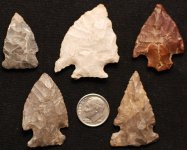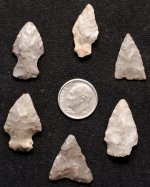- Mar 30, 2020
- 445
- 3,166
- Primary Interest:
- All Treasure Hunting
I'm happy this site also includes some Native American artifacts. I know that when I am out detecting I also have my radar on for stone artifacts, especially when crossing erosion points. These are some of my favorite finds from my youth nearly 45 years ago when I was a teen picking the turned cornfields of rural upstate NY. I like the small game and bird points, more challenging to find. The large white piece was recently mounted by a professional jeweler and it is now a necklace for my daughter.
I grew up in Allegany and Cattaraugus Counties in southwestern New York State, home to the great Seneca peoples (and those who preceded them including Mound-building cultures). The hobby required and developed the skills of concentration and observation. This training became valuable later in my life when I worked as a professional archaeologist and completed graduate level studies in Cultural and Natural Resources Management. Back in the summer of 1978 I served on a research team as an Earthwatch Scholarship winner locating and recording Native American petroglyphs (rock carvings) in the Black Mountains of the high Mojave north of Barstow and south of Death Valley. In 1980 I returned as Camp director for three more of these petroglyph expeditions, cataloging hundreds of them. I also worked as a contract field archaeologist for the reopening of Fort Irwin in the CA Mojave, a huge piece of desert used for live fire training exercises. In 1980 the US Military was forming battle plans to counter Soviet-style armored infantry columns as a response to the invasion of Afghanistan. Essentially a game of laser tag using helicopters, tanks, and jets against a resident force trained in these tactics and led by a defected Soviet Commandant. US Rapid Deployment Forces trained here then progressed to operation Bight Star in Egypt. We had to make sure sites weren't blown up and in the process located several National Historic Register Sites. My best find was locating two perfect clovis spear points laying side by side on the desert floor. Other highlights included being selected to a crack six man archaeological unit tasked to survey the Goldstone Tracking Facility run by NASA and JPL. Worked in fields of parabolic dishes which moved to track satellites. I watched what I believe was the second Shuttle Mission land at Ft. Edwards, standing near to the runway.
I digress...Seeing finds posted here keeps me going. I have been putting in a lot of leg work detecting but have little to show for it lately. The sport is painful when you find some nice things then strike out for days. But I keep swinging.

I grew up in Allegany and Cattaraugus Counties in southwestern New York State, home to the great Seneca peoples (and those who preceded them including Mound-building cultures). The hobby required and developed the skills of concentration and observation. This training became valuable later in my life when I worked as a professional archaeologist and completed graduate level studies in Cultural and Natural Resources Management. Back in the summer of 1978 I served on a research team as an Earthwatch Scholarship winner locating and recording Native American petroglyphs (rock carvings) in the Black Mountains of the high Mojave north of Barstow and south of Death Valley. In 1980 I returned as Camp director for three more of these petroglyph expeditions, cataloging hundreds of them. I also worked as a contract field archaeologist for the reopening of Fort Irwin in the CA Mojave, a huge piece of desert used for live fire training exercises. In 1980 the US Military was forming battle plans to counter Soviet-style armored infantry columns as a response to the invasion of Afghanistan. Essentially a game of laser tag using helicopters, tanks, and jets against a resident force trained in these tactics and led by a defected Soviet Commandant. US Rapid Deployment Forces trained here then progressed to operation Bight Star in Egypt. We had to make sure sites weren't blown up and in the process located several National Historic Register Sites. My best find was locating two perfect clovis spear points laying side by side on the desert floor. Other highlights included being selected to a crack six man archaeological unit tasked to survey the Goldstone Tracking Facility run by NASA and JPL. Worked in fields of parabolic dishes which moved to track satellites. I watched what I believe was the second Shuttle Mission land at Ft. Edwards, standing near to the runway.
I digress...Seeing finds posted here keeps me going. I have been putting in a lot of leg work detecting but have little to show for it lately. The sport is painful when you find some nice things then strike out for days. But I keep swinging.








